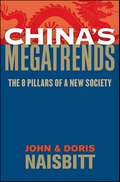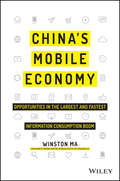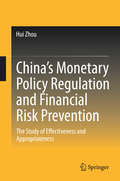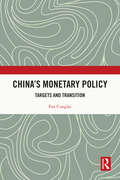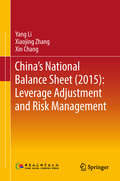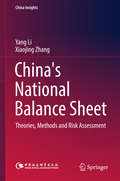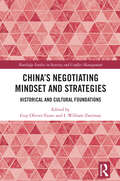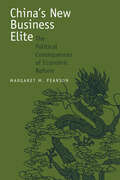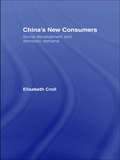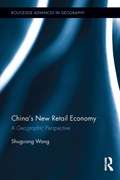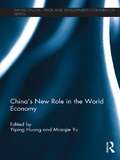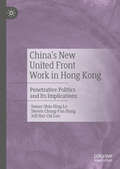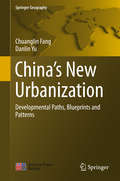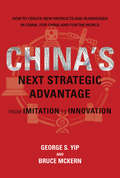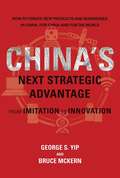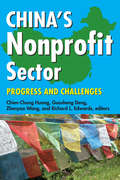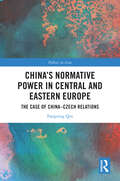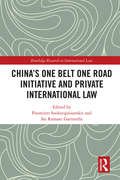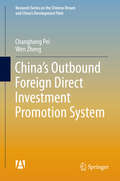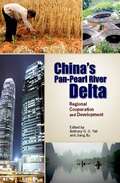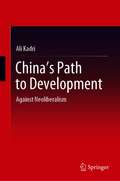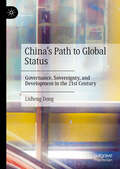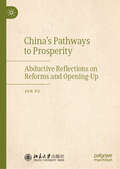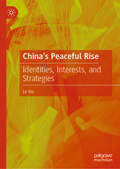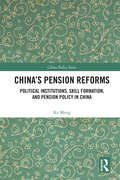- Table View
- List View
China's Megatrends: The 8 Pillars of a New Society
by John Naisbitt Doris Naisbitt“[John Naisbitt’s] vision of the world’s economy has the mark of genius.” —Minneapolis Star TribuneInternationally-renowned futurist and bestselling author John Naisbitt is back with China’s Megatrends, the most comprehensive look at the present and future of China and the transformation that is reshaping its economic, political, and social systems. Since publishing the enormously popular Megatrends—a New York Times bestseller for two years that has been published in 57 countries—John Naisbitt has become the most respected and well-known prognosticator of global trends. To write China’s Megatrends, Naisbitt and wife Doris were granted unprecedented access by the Chinese government to all aspects of the country and its social model. Using the same techniques of information gathering and analysis as Megatrends, the Naisbitts present a prescient and unique perspective on the emergent global power and its role in the future of globalization.
China's Mobile Economy: Opportunities in the Largest and Fastest Information Consumption Boom
by Dominic Barton Xiaodong Lee Winston MaExplore the world-changing digital transformation in China China's Mobile Economy: Opportunities in the Largest and Fastest Information Consumption Boom is a cutting-edge text that spotlights the digital transformation in China. Organised into three major areas of the digital economy within China, this ground-breaking book explores the surge in e-commerce of consumer goods, the way in which multi-screen and mobile Internet use has increased in popularity, and the cultural emphasis on the mobile Internet as a source of lifestyle- and entertainment-based content. Targeted at the global business community, this lucid and engaging text guides business leaders, investors, investment banking professionals, corporate advisors, and consultants in grasping the challenges and opportunities created by China's emerging mobile economy, and its debut onto the global stage. Year 2014-15 marks the most important inflection point in the history of the internet in China. Almost overnight, the world's largest digitally-connected middle class went both mobile and multi-screen (smart phone, tablets, laptops and more), with huge implications for how consumers behave and what companies need to do to successfully compete. As next-generation mobile devices and services take off, China's strength in this arena will transform it from a global "trend follower" to a "trend setter." Understand what the digital transformation in China is, and impact on global capital markets, foreign investors, consumer companies, and the global economy as a whole Explore the e-commerce consumption boom in the context of the Chinese market Understand the implications of the multi-screen age and mobile Internet for China's consumers See how mobile Internet use, its focus on lifestyle and entertainment is aligned with today's Chinese culture Learn about the mobile entertainment habits of China's millennial generation and the corresponding new advertisement approaches The development of China's mobile economy is one of the most important trends that will reshape the future of business, technology and society both in China and the world. China's Mobile Economy: Opportunities in the Largest and Fastest Information Consumption Boom introduces you to the digital transformation in China, and explains how this transformation has the potential to transform both China and the global consumer landscape.
China's Monetary Policy Regulation and Financial Risk Prevention: The Study of Effectiveness and Appropriateness
by Hui ZhouThis book utilizes an innovative approach combining qualitative and quantitative methods to investigate the correlations between monetary policy, economic growth, inflation and asset price volatility, explores the creation of financial risk prevention systems and reaches conclusions with both theoretical and practical value. The book offers an empirical analysis of the effectiveness of monetary policy, specifies the correlations between monetary policy, economic growth and inflation and provides a theoretical basis for and empirical demonstration of monetary policy implementation in China. Previous research in China has primarily focused on the correlation between monetary policy and a specific asset price, while this book comprehensively addresses the appropriateness of real estate, stock, bond and futures price regulation through monetary policies, lending it a high degree of practical significance. In order to arrive at a systemic risk prevention and regulation mechanism for China, the book uses the GARCH mean value model and MGARCH-BEKK model to create a pressure index and provide a three-level pre-warning system for currency crises, bank crises and asset bubble crises. The book systemically introduces the idea of macro-prudential regulation into the Chinese financial system by first clarifying the necessity of implementing macro-prudential regulation in China and then proving its effectiveness in mitigating pro-cyclicality and enhancing steady economic growth by constructing a mitigation model.
China's Monetary Policy: Targets and Transition
by Fan ConglaiBy applying modern monetary theories to China’s reality, this book reviews the development practice of China’s monetary policy and discusses the transitional goals of China’s monetary policy in the new stage of high-quality economic development.The book focuses on the formation mechanism of China’s inflation from the perspective of learning expectations, adaptive learning and dual labor market structure. It examines the monetary policy objectives of inflation management in an open economy, analyzes the causes of China’s price fluctuations from a global perspective and discusses the optimal policy space of the optimal RME exchange rate regime and the synergy between finance and business cycles. The author proposes a policy framework of capital regulation to deal with financial shocks and provides monetary policy options to deal with financial and business cycles. This work helps readers to understand the internal theoretical logic of the target transition of China’s monetary policy framework and points out that China’s monetary policy reforms are driven by the economic contradictions it faces at different stages of development.The title will provide references for scholars, students and policymakers interested in China’s monetary policy and provide experience and guidance for other developing countries to set their monetary policy targets and promote the transition of the monetary system.
China's National Balance Sheet: Leverage Adjustment and Risk Management
by Xiaojing Zhang Xin Chang Yang LiThe book aims at perfecting the national governance system and improving national governance ability. It evaluates the balance sheets of the state and residents, non-financial corporations, financial institutions and the central bank, the central government, local government and external sectors – the goal being to provide a systematic analysis of the characteristics and trajectory of China’s economic expansion and structural adjustment, as well as objective assessments of short and long-term economic operations, debt risks and financial risks with regard to the institutional and structural characteristics of economic development in market-oriented reform. It puts forward a preliminary analysis of China’s national and sectoral balance sheets on the basis of scientific estimates of various kinds of data, analyzes from a new perspective the major issues that are currently troubling China – development sustainability, government transformation, local government debt, welfare reform, and the financial opening-up and stability – and explores corresponding policies, measures, and institutional arrangements.
China's National Balance Sheet: Theories, Methods and Risk Assessment (China Insights)
by Xiaojing Zhang Yang LiWith the goal of perfecting the national governance system and raising the country's governance capability, this book systematically analyzes the characteristics and trajectory of China's economic expansion and structural adjustment, while also assessing a variety of short-term debt and long-term economic performance and financial risks. In addition to discussing the market-oriented reform process at the stage of economic development, institutional and structural characteristics, it presents research on the country as a whole, its residents, non-financial corporations, financial institutions and central banks, the central government, local government, and other external sectors. On the basis of extensive data, the book analyzes the national and sectoral balance sheets in China and explores a number of major issues the country is currently facing, such as sustainable development, government restructuring, local debt, welfare reform, openness and stability of the financial system, etc. , as well as suitable policy measures and institutional arrangements for addressing them.
China's Negotiating Mindset and Strategies: Historical and Cultural Foundations (Routledge Studies in Security and Conflict Management)
by I. William Zartman Guy Olivier FaureThis book analyzes the mindset with which China enters into negotiations, and applies these insights into contemporary arenas of Chinese activity around the world.The volume presents and analyses the historical and cultural foundations of Chinese thinking as used in the practice of present-day negotiation. It begins by addressing the essence of Chinese negotiations and the Chinese mindset, turning to a section that presents the cultural foundations of that mindset and strategy. The concepts of Confucianism, Taoism, Yin-Yang, and Chinese military strategy are highlighted. The cases of the Belt-and-Road Initiative and the South and East China Seas are examined to show the application of these concepts, with one addressing business and economic negotiations and the other examining cases of negotiation in geopolitics. Finally, a synthesis of what has been learned is presented, which will contribute to negotiation theory and ultimately will help Western practitioners contemplating negotiation with Chinese diplomats and businesses, as well as being a basis for policy analysts’ understanding of Chinese practices in international relations.This book will be of much interest to students of international negotiation, foreign policy, business studies, and international relations, as well as practitioners and policymakers.
China's New Business Elite: The Political Consequences of Economic Reform
by Margaret M. PearsonThe transition from a planned to a market economy that began in China in the late 1970s unleashed an extraordinary series of changes, including increases in private enterprise, foreign investment, the standard of living, and corruption. Another result of economic reform has been the creation of a new class—China's new business elite. Margaret M. Pearson considers the impact that this new class is having on China's politics. She concludes that, contrary to the assumptions of Westerners, these groups are not at the forefront of the emergence of a civil society; rather, they are part of a system shaped deliberately by the Chinese state to ensure that economic development will not lead to democratization.
China's New Consumers: Social Development and Domestic Demand
by Elisabeth CrollExploring China's consumer revolution over the past three decades, this book shows a continuing cycle leading to excess supply and disappointing demand, at the centre of which lies exaggerated expectations of China's new consumers. Combining economic trends with the author’s anthropological background, China’s New Consumers details the livelihoods and lifestyles of China's new and evolving social categories who, divided by wealth, location and generation, have both benefited from and been disadvantaged by the past two decades of reform and rapid economic growth. Given that consumption is about so much more than shopping and spending, this book focuses on the perceptions, priorities and concerns of China's new consumers which are an essential part of any contemporary narrative about China's domestic market. Documenting the social consequences of several decades of rapid economic growth and the new interest in 'all-round' social development, China's New Consumers will be of value to students, entrepreneurs and a wide variety of readers who are interested in social trends and concerns in China today.
China's New Retail Economy: A Geographic Perspective (Routledge Advances in Geography #11)
by Shuguang WangRetail is the essential link between production and consumption. The dynamics of a nation’s economy cannot be fully understood without a good understanding of its retail sector. This book is written to achieve three broad objectives. First, it provides a comprehensive assessment of the changes in consumption patterns in China, the current size of the Chinese consumer market, and the regional variations. Second, it presents an interpretation of the changes in the country’s regulatory system and the corresponding policy initiatives, including the new state spatial strategies devised after its admission to the WTO. Third, it delivers a systematic analysis of the transformation of China’s retail sector. This includes the entry and expansion of foreign retailers, the development of indigenous retail chains as a national strategy to modernize China’s retail industry, and the changing retailer-supplier relations. This book is a useful reference not only for university students and faculty researchers, but also for international retailers and commercial real estate developers who contemplate business and investment opportunities in China.
China's New Role in the World Economy (PAFTAD (Pacific Trade and Development Conference Series))
by Miaojie Yu Yiping HuangThe remarkable rise of China over the past three decades has been unprecedented in both its scale and speed. Analysts around the world have attempted to understand the causes of this unique event and to predict how long it will last. China's rise has also raised two important questions. The first concerns the stability and the sustainability of China’s growth, which has been accompanied by growing internal and external imbalances, rising inequality at home, environmental degradation and an increased risk of catastrophic climate change, and has happened in spite of the continuing, if diminished, role of the state in many sectors of the economy. The second concerns trying to guess what the effect of China’s rise will be on its relations with the rest of the region, the world and the existing global order. It seems only a matter of time until China becomes the world’s largest economy, and history suggests that it is unthinkable that this event would be without geopolitical consequences. The chapters in this volume draw on papers originally presented to the 34th Pacific Trade and Development Conference held in Beijing in 2010 to discuss these two big questions and China’s changing role in the world economy. This book will be welcomed by students and scholars of Chinese economics, business and politics, and those interested in the pervasive impact of China’s development on the global economy.
China's New United Front Work in Hong Kong: Penetrative Politics and Its Implications
by Sonny Shiu-Hing Lo Steven Chung-Fun Hung Jeff Hai-Chi LooThis book explores the dynamics of China’s new united front work in Hong Kong. Mainland Chinese penetrative politics can be seen in the activities of local pro-Beijing political parties, clans and neighborhood associations, labor unions, women and media organizations, district federations, and some religious groups. However, united front work in the educational and youth sectors of civil society has encountered strong resistance because many Hong Kong people are post-materialistic and uphold their core values of human rights, the rule of law and transparency. China’s new united front work in Hong Kong has been influenced by its domestic turn toward “hard” authoritarianism, making Beijing see Hong Kong’s democratic activists and radicals as political enemies. Hong Kong’s “one country, two systems” is drifting toward “one country, two mixed systems” with some degree of convergence. Yet, Taiwan and some foreign countries have seen China’s united front work as politically destabilizing and penetrative. This book will be of use to scholars, journalists, and observers in other countries seeking to reckon with Chinese influence.
China's New Urbanization: Developmental Paths, Blueprints and Patterns (Springer Geography)
by Chuanglin Fang Danlin YuThis book answers the call for NewUrbanization, and proposesa "5+9+6" nationalspatial layout plan for the urbanizationof the 770 major cities in China. This macro pattern is based on a fewmajor metropolises at the center, and other cities supporting and benefitting from thesemetropolises to form a pyramid-like urban hierarchical system. The book also presents a comprehensiveregionalization plan for China's New Urbanization and strategic approaches to improving the quality of thisNew Urbanization. Currently, China is aggressively promoting a so-called New Urbanization, which has been regarded as one of the primaryways to build a moderately prosperous society, to address critical issuesrelated to agriculture,rural regions and farmers, to expand domestic demand and promote industrial innovation, and to realize the China Dream. From a systematic perspective and using recently released urban data, theauthors analyze the current status of New Urbanization in China and also investigatethe various potential problems and obstacles to its concrete implementation. Based on the analysesand investigations, the authors propose strategic directions, paths and basicprinciples for China's New Urbanization. In addition, they clearly identify the three differentmodes of New Urbanization, namely, the general mode, differentiated mode, and gradual mode. Today, many scholars argue that China's urban regions areexperiencing a highly unsustainable mode of development. Chinese cities areheavily burdened by theso-called "urban diseases,"which are characterized e. g. by congested traffic, polluted water and air, and a lack of open and green spaces. Traditionalurbanization, which primarily focuseson economic development, mustbe fundamentally reformed. New Urbanization, which focuses on integrated economic development,social integration and space/environmental sustainability, or simply put, on the quality ofurbanization, has been called for to provide a potential "cure" for these urban diseases. Due to the vastness of China'spopulation and its rapidly growing economic, political and cultural relationshipswith the rest of the world,the book demonstrates thatthe success of this New Urbanization is critical not only to the future of urban China,but also the future of urbanization worldwide. Thebook offers a valuable referencework for all researchers, graduate student and policy makers interestedin China's urban development.
China's Next Strategic Advantage: From Imitation to Innovation
by George S. Yip Bruce McKernA book for everyone who does business with China or in China. The history-making development of the Chinese economy has entered a new phase. China is moving aggressively from a strategy of imitation to one of innovation. Driven both by domestic needs and by global ambition, China is establishing itself at the forefront of technological innovation. Western businesses need to prepare for a tidal wave of innovation from China that is about to hit Western markets, and Chinese businesses need to understand the critical importance of innovation in their future.Experts George Yip and Bruce McKern explain this epic transformation and propose strategies for both Western and Chinese companies. This book is for everyone who does business with China or in China, or is interested in the development of the world's fastest-growing economy. Western CEOs can learn from Chinese companies and can create an effective innovation process in China, for China and the world. Chinese CEOs can benefit from understanding the strategies of their peers as they strive to enter foreign markets. And all Western businesses should prepare for disruption from their new competitors. Yip and McKern provide case studies of successful firms, outline ten ways in which the managerial and innovative capabilities of these firms differ from those of Western firms, and describe how multinationals doing business in China can become part of the Chinese ecosystem of new knowledge and technology. Yip and McKern argue that these innovation capabilities will be the basis for creating world-class products and services to meet the challenges of a new era of global competition.
China's Next Strategic Advantage: From Imitation to Innovation
by Bruce Mckern George S. YipThe history-making development of the Chinese economy has entered a new phase. China is moving aggressively from a strategy of imitation to one of innovation. Driven both by domestic needs and by global ambition, China is establishing itself at the forefront of technological innovation. Western businesses need to prepare for a tidal wave of innovation from China that is about to hit Western markets, and Chinese businesses need to understand the critical importance of innovation in their future.Experts George Yip and Bruce McKern explain this epic transformation and propose strategies for both Western and Chinese companies. This book is for everyone who does business with China or in China, or is interested in the development of the world's fastest-growing economy. Western CEOs can learn from Chinese companies and can create an effective innovation process in China, for China and the world. Chinese CEOs can benefit from understanding the strategies of their peers as they strive to enter foreign markets. And all Western businesses should prepare for disruption from their new competitors.Yip and McKern provide case studies of successful firms, outline ten ways in which the managerial and innovative capabilities of these firms differ from those of Western firms, and describe how multinationals doing business in China can become part of the Chinese ecosystem of new knowledge and technology. Yip and McKern argue that these innovation capabilities will be the basis for creating world-class products and services to meet the challenges of a new era of global competition.
China's Nonprofit Sector: Progress and Challenges (Asian Studies)
by Chien-Chung HuangThe nonprofit sector in China (including nongovernmental organizations, foundations, and charities) is fairly new, especially to foreigners, since the rapid development of this "third sector" has not been widely studied in Western scholarship. The contributors to this volume have been engaged in research of China's nonprofit sector for many years, and are intimately familiar with the operation of Chinese nonprofit organizations. China's Nonprofit Sector describes the development of China's nonprofit sector since 1995, including discussions on the rise of corporate responsibility and charitable foundations, grassroots organizations, and the microphilanthropy that arose after the Sichuan earthquake in 2008. It enumerates the shifting legal framework, the complex relationship between government-affiliated and private sector organizations, the media's role, the emergence of microphilanthropy, and the lack of knowledge of the general public regarding philanthropic enterprises. This volume, in Transaction's Asian Studies series, directly addresses the topic of China's nonprofit sector and gives a coherent and comprehensive account of its development and challenges. This work will be of value for all policy specialists, Asian Studies scholars, and all individuals interested in China.
China's Normative Power in Central and Eastern Europe: The Case of China-Czech Relations (Politics in Asia)
by Fangxing QinQin explores the ten-year development of relations between China and Central and Eastern Europe through the China–CEEC (China–Central and Eastern European Countries) cooperation (16/17+1), which began as a platform for annual high-level meetings between leaders of China and Central and Eastern Europe (CEE) countries, and to stimulate new dynamism and gain recognition through effective shared practice.This book analyses the process of co-construction of shared practices between China and the Czech Republic through China–CEEC cooperation from 2012 to 2021 from the perspective of normative power. It proposes the concept of ‘earning recognition’ that provides a specific analytical path for dynamically measuring whether an actor could be seen as having normative power and brings new insights from the perspective of normative power to the debates on China’s ideational influence in the CEE region. It provides a wealth of empirical evidence for reflecting on the failure of China’s approach in the Czech Republic, adding an important piece of the puzzle to the study of China–CEE relations.A valuable resource for scholars and practitioners in the field of international relations and China studies, especially those who specialise in China–CEE relations and those interested in China’s impact on the world, the Central and Eastern European region, and the competition for influence among major powers.
China's One Belt One Road Initiative and Private International Law (Routledge Research in International Law)
by Sai Ramani Garimella Poomintr SooksripaisarnkitThe concept of the One Belt One Road initiative (OBOR) was raised by the President of the People’s Republic of China in October 2013. The OBOR comprises the ‘Silk Road Economic Belt’ and the ‘21st Century Maritime Silk Road’, encompassing over 60 countries from Asia to Europe via Southeast Asia, South Asia, Central Asia, West Asia, and the Middle East. The overall objective of the OBOR is to encourage the economic prosperity of the countries along the Belt and Road and regional economic cooperation, encourage mutual learning between different civilizations, and promoting peace and development. However, countries along the Belt and Road routes of the OBOR project have diverse laws and legal systems. It is not difficult to envisage problems relating to harmonisation of laws and rules in trade between countries along the OBOR routes or otherwise. These problems can potentially cut through the core of the very objective of the OBOR itself. Integration in China’s One Belt One Road Initiative explores possible challenges to the success of the OBOR arising from the situational interface of diversity of laws, with the focus primarily on issues associated with private international law. It shows the latest state of knowledge on the topic and will be of interest to researchers, academics, policymakers, and students interested in private international law issues pertaining to the OBOR routes as well as private international law in general, Asian studies, and the politics of international trade.
China's Outbound Foreign Direct Investment Promotion System (Research Series on the Chinese Dream and China’s Development Path)
by Changhong Pei Wen ZhengThis book outlines China's current overseas investment promotion system, analyzing the general situation and the main problems arising during its development. Based on investigations of both the historical and present-day contexts of outbound investment, the book suggests improvements to overseas investment promotion to protect China's enterprises from various aspects of the system including legal, regulatory, fiscal, intellectual property rights and standardization, risk prevention, foreign trade and economic cooperation zones to promote overseas securities investment promotion and social services.
China's Path to Development: Against Neoliberalism (Springerbriefs In Political Science Ser.)
by Ali KadriThis book is a treatise against neoliberalism illuminated by the path of China. China is a model to be mimicked, but more so theoretically than by replication. If anything, nations of the global South must rid themselves of neoliberally imposed ‘one-size-fits all’ models, instrumentalised to shift value to US empire. Neoliberal models, robbing nations of their histories and resources, are negative ‘best practice’ serving the interests of the hegemon. Developing nations need to search for the theory that corresponds to their own conditions and development strategies. China’s experience, anchored in labour as the historical agent, offers numerous theoretical cues as to how to build comparable home-grown paths. Thinking development with a subject voids reductionist politics in favour of sober class analysis. The study concludes by restating the age-old wisdom that there is no development without the rule of labour.
China's Path to Global Status: Governance, Sovereignty, and Development in the 21st Century
by Lisheng DongThis book offers a comprehensive exploration of China&’s governance evolution, focusing on its domestic transformation and the global political impact. The book charts China's trajectory from the reform and opening-up under Deng Xiaoping to the strategies employed by Xi Jinping, emphasizing the shifts in ideology, centralized governance, economic models, and international ambitions. It combines historical context, theoretical insights, and a nuanced comparison of key Chinese leaders, presenting a rich narrative that ties domestic policy to global aspirations.
China's Pathways to Prosperity: Abductive Reflections on Reforms and Opening-Up
by Jun FuShifting gears between the most abstract (invisible) and the most concrete (visible) world, this book contains one unifying theoretical construct and six milestone stories to shed light on China&’s pathways towards building a moderately prosperous society since 1949. Today, China&’s GDP per capita is about US$ 12,000; it was only about US$ 150 in the late 1970s, that is, before the reform era. That is a very dramatic increase, lifting over 700 million people out of poverty in the process! What is unique about this book is that the six stories, when read together, systematically unfold a simple coherent logic — as well as a rich history — of economic development in the complex institutional setting of politics, economics and sociology that is uniquely Chinese. A key educational feature of the book is for the reader to learn and appreciate both the universals (or global vision) and the particulars (or local knowledge) of these stories so as to gain a deeper understanding of China&’s development trajectory in a global setting in the past several decades. In other words, for China&’s growth strategies to work, theories must be contextualized dynamically by local conditions. This book will be appreciated by students and educators alike.
China's Peaceful Rise: Identities, Interests, and Strategies
by Le HuThis book examines the extent to which China has stabilized its communist regime and defended or pursued its crucial nationalist interests while maintaining a relatively peaceful environment in East Asia. Despite a politics which would seem to be unassimilable and assertive policies regarding sovereignty disputes or the Taiwan question, China exists more or less peacefully within East Asia. This raises an important question: how has this being done? Using Social Identity Theory and Chinese Communist Party’s united front strategy, the author uncovers new angles on the mentality and trajectory of Chinese foreign policy, in a study that will interest scholars, policymakers and journalists.
China's Pension Reforms: Political Institutions, Skill Formation and Pension Policy in China (China Policy Series)
by Ke MengExisting literature has looked at many factors which have shaped Chinese pension reforms. As China’s pension reform proceeds in an expanding and localising fashion, this book argues that there is a pressing need to examine it in the context of China’s political institutions and economic transformations. The book takes a unique approach by looking at political institutions of the Chinese state and the changing conditions of the Chinese economy, which rarely receive proper treatment in the current analysis of China’s pension reforms.
